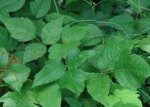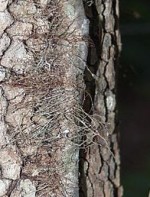 Poison ivy is a perennial native to eastern, and mid-western United States and is found in all U.S. states east of the Rocky Mountains. It grows well in shaded areas and is especially common along the edges of fields and woods but can also grow in the full sun of open fields. It is not fussy about soil moisture and even grows in areas that are prone to seasonal flooding. The plant sap contains urushiol which can cause inflammation, blistering, and itching skin in about 70% of the population. On the other hand, poison ivy is an important browse species and provides berries in fall, winter and early spring for a large number of birds. Photo Credit Wikipedia
Poison ivy is a perennial native to eastern, and mid-western United States and is found in all U.S. states east of the Rocky Mountains. It grows well in shaded areas and is especially common along the edges of fields and woods but can also grow in the full sun of open fields. It is not fussy about soil moisture and even grows in areas that are prone to seasonal flooding. The plant sap contains urushiol which can cause inflammation, blistering, and itching skin in about 70% of the population. On the other hand, poison ivy is an important browse species and provides berries in fall, winter and early spring for a large number of birds. Photo Credit Wikipedia

 Description: Poison ivy can be a trailing or climbing vine as well as a shrub. No matter where it grows the vine can be recognized by its leaves. In early spring when the leaves first appear they are reddish, turning to shiny green as they mature, and bright yellow or red in the fall. Each leaf is actually composed of three oval leaflets with pointed tips, carried on their own stem. The little rhyme, “Leaves of three, let it be” is a good aid in distinguishing poison ivy from other benign look-alike vines but will not distinguish it from poison oak which also has three leaves. The stems of poison ivy grow up to twenty feet long and become woody with age. They can root if they come in contact with the soil and can climb other plants and structures such as fences attaching themselves by means of a mass of adventitious roots. The rhyme “Raggy rope, don’t be a dope” is a good way to remember to avoid touching such an object when encountered in a woods. When the vine is mature, about three years old, it may produce clusters of pale green flowers in the leaf axils. Gray to white berries follow. The root system is fibrous. Photo credit Wikipedia
Description: Poison ivy can be a trailing or climbing vine as well as a shrub. No matter where it grows the vine can be recognized by its leaves. In early spring when the leaves first appear they are reddish, turning to shiny green as they mature, and bright yellow or red in the fall. Each leaf is actually composed of three oval leaflets with pointed tips, carried on their own stem. The little rhyme, “Leaves of three, let it be” is a good aid in distinguishing poison ivy from other benign look-alike vines but will not distinguish it from poison oak which also has three leaves. The stems of poison ivy grow up to twenty feet long and become woody with age. They can root if they come in contact with the soil and can climb other plants and structures such as fences attaching themselves by means of a mass of adventitious roots. The rhyme “Raggy rope, don’t be a dope” is a good way to remember to avoid touching such an object when encountered in a woods. When the vine is mature, about three years old, it may produce clusters of pale green flowers in the leaf axils. Gray to white berries follow. The root system is fibrous. Photo credit Wikipedia

 Control: Given the harm that poison ivy can do to the skin, every effort should be made to eliminate it in garden areas where contact with it is likely. Pets, clothing, and tools that have contact with the vine can carry urushiol from the vine to a person so even a small patch can cause trouble. When dealing with poison ivy always wear gloves, long pants, and a long sleeve shirt and wash them well after contact with the plant. Cut small plants as close to the root as possible and leave them to dry; sever mature vines on trees from there root system. Never burn poison ivy as the smoke will contain urushiol that can cause severe lung damage. In late spring or early summer when poison ivy is growing vigorously herbicides containing glyphosate can be used effectively to eliminate the weed.
Control: Given the harm that poison ivy can do to the skin, every effort should be made to eliminate it in garden areas where contact with it is likely. Pets, clothing, and tools that have contact with the vine can carry urushiol from the vine to a person so even a small patch can cause trouble. When dealing with poison ivy always wear gloves, long pants, and a long sleeve shirt and wash them well after contact with the plant. Cut small plants as close to the root as possible and leave them to dry; sever mature vines on trees from there root system. Never burn poison ivy as the smoke will contain urushiol that can cause severe lung damage. In late spring or early summer when poison ivy is growing vigorously herbicides containing glyphosate can be used effectively to eliminate the weed.